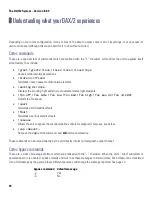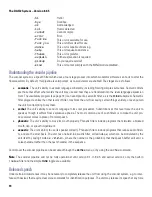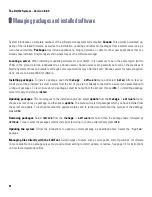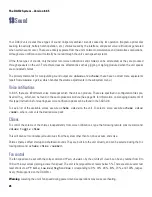
The DAX/2 System – Version 8.0.5
13
sxd-cocky, sxd-compliant, sxd-curious, sxd-dismissive, sxd-furious, sxd-growl, sxd-hmm, sxd-laugh,
sxd-marquise, sxd-mmm, sxd-moan, sxd-moo, sxd-pythia, sxd-sass, sxd-terse
You are free to install additional speech profiles into the audio processor, or, if you would like the assets to be
fetched directly as needed, provide the UUID here of a speech profile instead.
The
third and successive lines
specify the preset messages that the unit may use when the mind is disabled. By
default, these messages are parsed in a fixed order, and can be accessed by the unit (or a remote user relaying
speech commands) with the following mnemonics:
.y, .n, .hi, .bye, .ok, .lol, .cannot, .error, .fuck me, .fuck you, .dance, .help, .thanks, .explain, .pickup, .mind
The preferred separator for these messages is the vertical bar or “pipe”
|
, but due to technical limitations only 255
characters can be read from a given line, so line-breaks may be substituted instead.
Tip
: Loading configuration files with many lines takes longer. Use pipes whenever possible to keep your personas
compact and efficient.
Installing personas
The primary file of your persona should be named
p_<
persona>
, where
<persona>
is the name you want to appear on
the command menu. It does not necessarily have to match the first line of the file. Should you wish to use Arabesque script-
ing with your persona (see page 27), name the corresponding script file
px_
<persona>
.
To install these files, they must be placed in the unit’s writable memory. See page 32 for more information.
To activate your unit’s new persona:
Via the remote console
, type the following:
persona
<persona>
Via the display screen or teletype interface
, select the persona name from the
personas
menu.
After installing the persona, it may be necessary to
refresh
the menu before it will appear.
Extending the preconfigured message set
As of version 8.0, the SXD firmware permits adding more preset messages to the persona than those specified in a standard
persona. After the end of the persona’s normal messages, include messages in the following format:
<command>
:=
<message>
e.g.
maybe:=Perhaps.
Where
<command>
is the input provided by the unit or remote operator to activate the command, and
<message>
is what
will be said as a result. The period will be prefixed automatically.














































